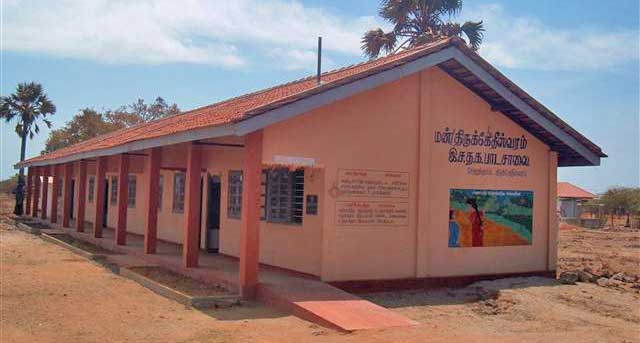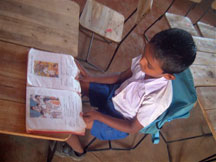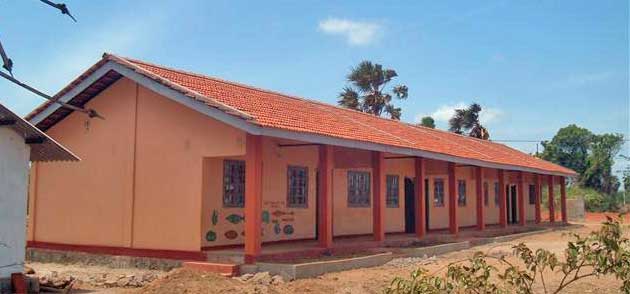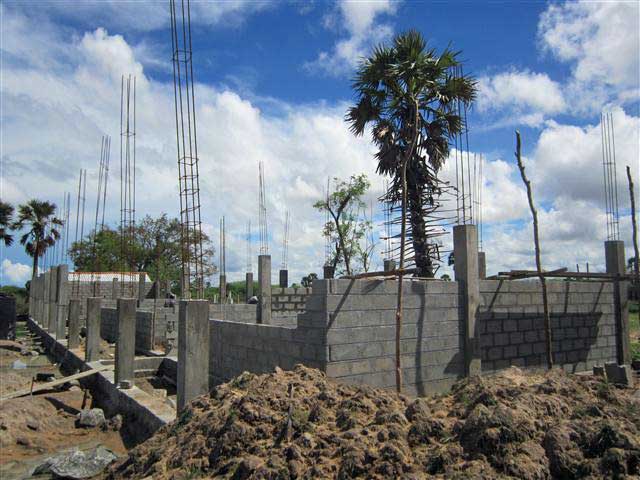Thiruketheeswaram Hindu Board Tamil Mixed School opened August 2011

The New School!

Chatukulam Community Profile
The village of Chatukulam is located in Mannar District, 330 kilometers north of Colombo. This region was greatly affected by war, and as a result many of the roads are in poor condition. Due to the neglected condition of the roads, it takes about eight hours to reach the village from Colombo.
The school is located in the village of Chatukulam, Mannar District. This district, one of five administrative districts in the Northern Province, is located in northwestern Sri Lanka. It covers 2,002 square kilometers, approximately 3% of the total land area of Sri Lanka. Geographically, the bulk of Mannar lies on the mainland within the arid and dry zone. High temperatures and low rainfall characterize the climate. The monthly temperatures range between 26°C and 30°C, with highs normally recorded between May and August. Mannar receives nearly 60% of its rainfall during the northeast monsoon, which lasts from October through December. The land area is relatively flat and sits at low elevations. Across the region's gently undulating terrain, rainwater is stored in tanks and used for irrigation of arable land. Crop cultivation (primarily paddy), fisheries and animal husbandry support most people in Mannar. Employment opportunities in the district are highly seasonal, and there are no institutional facilities for tertiary education. The district is inhabited by members of various communities, though the Tamil- speaking community is the most prevalent.
The last thirty years of conflict in the region have resulted in the displacement and destruction of large segments of the area's population. War has destroyed the region's infrastructure, displacement has left communities without homes, and the jungle has swallowed formerly populated areas.
The residents of Chatukulam are very poor due to the decades-long war. Displaced on multiple occasions, these villagers have lost their houses, their belongings, and many of their loved ones as well. The shelters consist of temporary tin sheet sheds built by the government or INGOs. The villagers are dependent on cultivation as their main source of income and many of them work for daily wages. Drinking water is obtained from dug wells, and the village is without an electricity supply. Presently the government is involved in demining the village and rebuilding the infrastructure.
The school is located in the village of Chatukulam, Mannar District. This district, one of five administrative districts in the Northern Province, is located in northwestern Sri Lanka. It covers 2,002 square kilometers, approximately 3% of the total land area of Sri Lanka. Geographically, the bulk of Mannar lies on the mainland within the arid and dry zone. High temperatures and low rainfall characterize the climate. The monthly temperatures range between 26°C and 30°C, with highs normally recorded between May and August. Mannar receives nearly 60% of its rainfall during the northeast monsoon, which lasts from October through December. The land area is relatively flat and sits at low elevations. Across the region's gently undulating terrain, rainwater is stored in tanks and used for irrigation of arable land. Crop cultivation (primarily paddy), fisheries and animal husbandry support most people in Mannar. Employment opportunities in the district are highly seasonal, and there are no institutional facilities for tertiary education. The district is inhabited by members of various communities, though the Tamil- speaking community is the most prevalent.
The last thirty years of conflict in the region have resulted in the displacement and destruction of large segments of the area's population. War has destroyed the region's infrastructure, displacement has left communities without homes, and the jungle has swallowed formerly populated areas.
The residents of Chatukulam are very poor due to the decades-long war. Displaced on multiple occasions, these villagers have lost their houses, their belongings, and many of their loved ones as well. The shelters consist of temporary tin sheet sheds built by the government or INGOs. The villagers are dependent on cultivation as their main source of income and many of them work for daily wages. Drinking water is obtained from dug wells, and the village is without an electricity supply. Presently the government is involved in demining the village and rebuilding the infrastructure.
Why a new school?
This school serves students in grades one through five. Presently, classes at the school are conducted in a temporary shed built with timber and a thatched roof. The classes are not partitioned, so it's hard for the teachers to hold the students' attention. On rainy days, the roof leaks, so the classes have to be postponed. Due to the poor infrastructure, some parents do not send their children to school.

A young student hard at work
The School project

The new primary school building is approximately 2,500 square feet. It is a spacious building with plenty of light and good ventilation, and it is an attractive addition to the community. The exterior of the building is painted to match the existing buildings at the school. The single story building has five classrooms, as well as storage facilities. There are built-in concrete wall cupboards, which the teachers use for displaying various educational materials donated by Opportunity for All and Room to Read. Opportunity for All and Room to Read has provided 100 student tables, 200 student chairs, and 5 sets of tables and chairs for the teachers.


